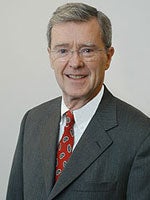Over the past decade, the U.S. Supreme Court has overruled the U.S. Court of Appeals for the Ninth Circuit in 148 of 182 cases—a “strikingly poor record” for the circuit court, said Ninth Circuit Judge Diarmuid O’Scannlain ’63 in a talk at Harvard Law School on September 17. The event was sponsored by the Federalist Society.
O’Scannlain, who is entering his 25th year on the federal bench, said he wanted “to reflect on how cases from my own court have fared in the Supreme Court over the past decade.” The Ninth Circuit, he said “got it wrong in 81% of its cases that the Supreme Court agreed to hear.”
“Compare that to the affirmance rate of over 80% in all appeals from lower courts and federal agencies decided by us.”
The circuit’s reversal rate troubles the long-time and much distinguished O’Scannlain, whose appellate division spans from the northwest United States and California to Alaska and Hawaii.
“Even more telling than the reversal rate itself, however, is the number of unanimous reversals. Seventy-two of the 148 Ninth Circuit cases reversed during the period in question were at the hands of a unanimous Supreme Court.”
Some of these cases, according to O’Scannlain, are ones in which the circuit court’s error is so significant that it is acknowledged across the Supreme Court’s ideological spectrum. Fifteen of the 72 unanimous reversals resulted in summary dispositions in which neither briefing nor argument was required.
O’Scannlain cited Yale Law School Professor Akhil Amar, who has said that when the Ninth Circuit is “not picking up the votes of anyone on the [Supreme] Court, something is screwy.”
“Put differently, in about one-half of all the cases in which the Ninth Circuit was reversed, not a single Justice agreed with the Ninth Circuit’s decision,” he said.
O’Scannlain said his Ninth Circuit colleagues’ “misuse of broad standards” results in many of the reversals—especially in habeas corpus proceedings assessing the legality of state prisoners’ convictions and sentences.
“It seems that at least once every term, the Supreme Court has to remind us about the proper standard of review in habeas proceedings under the Antiterrorism and Effective Death Penalty Act (affectionately called AEDPA).”
He continued, “AEDPA prohibits federal courts from granting habeas relief to state prisoners on constitutional claims adjudicated in state court, unless the state-court decision ‘was contrary to, or involved an unreasonable application of, clearly established Federal law, as determined by the Supreme Court.’”
The judge suggested that the Ninth Circuit is generally not following the guidelines of AEDPA and, in effect, is abusing its authority of constitutional review.
O’Scannlain added that Justice Sonia Sotomayor’s first term on the Supreme Court did not affect the frequency of unanimous reversals of Ninth Circuit decisions.
Judge O’Scannlain participated in a brief Q&A after the lecture with HLS reporter Alexander Heffner:
Q: What do you say to your left-leaning colleagues who argue that their disagreement with the Supreme Court is good for democracy?
A: Most of our function is to be predictable – the rate of reversals is not healthy. I disagree with them, and we’re allowed to.
Q: You mentioned you remember Harvard Law fondly. What did your graduate work in Cambridge teach you most?
A: Analysis: training the mind to analyze every situation in great depth and width. It also taught me a healthy respect for the rule of law as it applies in our own country…and the importance of thorough research. A lot of black letter law was less important than the ability to approach every problem with analytical skills.
Q: What’s the most intellectually rigorous—or maybe sensitive issue—you’ve dealt with on the Court?
A: Prop 209, definitely. A tough issue involving affirmative action.
Q: I see you with a very sleek and judicious-looking BlackBerry. How is technology being used in your Oregon-based office and in the courthouses across the 9th Circuit?
A: My life has changed dramatically since I first came on the Court. We initially had a very outmoded system to help us communicate within the court. Now judges and their clerks are each equipped with the newest technology.
Q: You are a vocal advocate of splitting the Ninth Circuit given its wide geographic spread and case backlog…
A: I don’t see much reform going on right now. I would love it if we – say, a committee of top people – could take a look at the whole system and decide what needs to be changed.
Q: What’s your overall assessment of the judiciary in 2010?
A: We have the finest system in the world – what we’re able to do, observed faithfully, implemented on a daily basis, with the Supreme Court looking over us.
